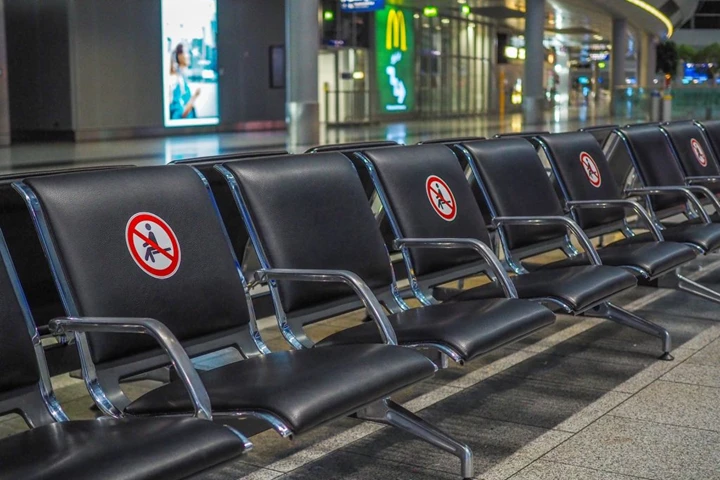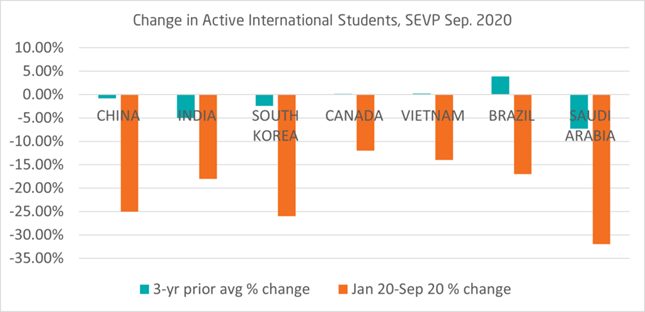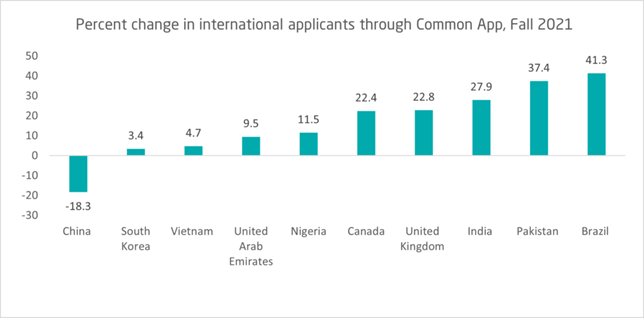2021 in focus: Asymmetric recovery among top sending countries for international students in U.S.

At the end of last year, the Student and Exchange Visitor Program (SEVP) released data on active international student records from September 2020, offering new insights into how COVID-19 has affected the number of international students in the U.S.* INTO, NAFSA, and the Association of Public and Land-grant Universities recently outlined quick facts from the data in an update to our groundbreaking report, Factors Influencing U.S. International Student Enrollment Growth and Decline.
Among other trends, the new SEVP data show that the number of students from China, South Korea, and Saudi Arabia—three of the top seven sending countries for international students in the U.S.—decreased far more significantly as a result of the pandemic than the number of those coming from India, the second-most sending country. Furthermore, additional data on F-1 visa issuances and international student applications for fall 2021 admission show that interest in U.S. study in India and other South Asian countries has rebounded quickly as vaccines roll out and global student mobility slowly resumes, while the number of students coming to the U.S. from China and other top sending countries continues to stagnate or decline.
SEVP data indicate that the total number of international students at U.S. institutions decreased by an average of 1.7% over the last three years. During that time, the number of students from China, India, South Korea, and Saudi Arabia fell by 0.83%, 4.97%, 2.43%, and 7.27%, respectively. These rates of change serve as baselines against which we may consider more severe, pandemic-related declines.
Between January and September 2020, COVID-19 caused an unprecedented 21% drop in the number of students in the U.S. from all corners of the globe. This constitutes a decline 19.3 percentage points in excess of that expected for 2020, given the 1.7% average decrease from 2017-19.

In the same nine months, the number of Chinese, South Korean, and Saudi Arabian students declined by 25%, 26%, and 32%, respectively. Given the prior three-year average rates of change for China, South Korea, and Saudi Arabia, these pandemic-induced plunges represent excess declines of 24.17 percentage points, 23.57 percentage points, and 24.73 percentage points, respectively. In all three cases, the negative rate of change and excess decline were greater than that associated with the total number of international students in the U.S.
In the case of India, however, the number of students sent to the U.S. shrank by 18% between January and September 2020, representing an excess decline of just 13.03 percentage points. This rate of change and excess decline were less severe than those associated with the total number of international students in the U.S. as well as the number of students from other top sending countries.
Moreover, recent U.S. State Department data suggest that student travel to the U.S. from India and other South Asian countries is rebounding more quickly than it is in other key markets. The number of F-1 visas issued to students from China, South Korea, and Saudi Arabia between September 2020 and January 2021 decreased by 89%, 44%, and 52%, respectively, compared to the same period the previous year. On the other hand, the number of F-1 visas issued to students from India and Pakistan during the same period increased by 79% and 85% over the previous year, respectively.
You can explore the most recent data on F-1 visa issuances with our interactive graphic below:
At the same time, the number of Indian and Pakistani applicants for fall 2021 admission to U.S. universities through the Common App has risen by 41.3% and 37.4% over the prior year, respectively. Meanwhile, the number of applicants from all sending countries has risen by just 9%, the number of South Korean applicants has risen by just 3.4%, and the number of Chinese applicants has decreased by 18.3% compared to the previous year.

Long-term recovery for international enrollments for American universities will depend on how the U.S. continues to make its immigration system more welcoming, and on the national response to COVID-19 and systemic racism, including the recent surge in violence against members of the AAPI community. Still, the signs of reinvigorated interest and growth from India and other South Asian countries should offer hope for the international education sector in the U.S.—and they should guide institutions’ enrollment strategies in the year ahead.
*SEVP only publishes data on active Student and Exchange Visitor Information System (SEVIS) records, not actual enrollment. Active SEVIS records include some students enrolled outside the United States, and excludes new international students who enrolled online from outside of the U.S.
Cover Image by Michael Gaida from Pixabay.